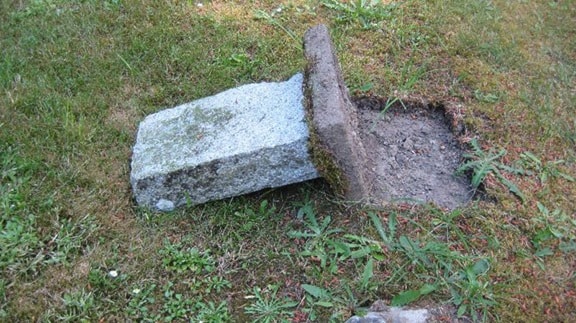In this third and final instalment we wrap up our visit to the Valley’s oldest cemetery which was desecrated by vandals two weeks ago.
Mary Frances Botterill, the third daughter of Matt and Mary Botterill, was just 17 years and four months at the time of her passing, April 10, 1885. Her headstone, mid-cemetery, intrigues visitors with its poignant epitaph: A light from our household has gone; A voice we loved is still; A place is vacant in our home That can never be filled.
Parents Mary Botterill, who died June 5, 1903, and Matthew Botterill, a native of Westow, Yorkshire, England, who died April 18, 1871, are beneath the red column: We loved you most who loved you best.
You can hardly read the inscription on William Manley’s concrete headstone which, with that of Robert J. Manley, 1868 – 1959, is almost mid-cemetery. William Jr. and twin brother Robert are thought to be the first white children born in the Cowichan Valley. Fortunately for Robert, his headstone is of bronze.
William Manley (Sr.) inspired the naming of Cobble Hill’s Manley Creek. No more than half a mile long, it flows northeasterly into Satellite Channel, between Hatch and Cherry Points.
Although one of Cowichan’s earliest settlers, the Irishman wasn’t the first to settle there, the 200 acres he pre-empted in the early 1860s upon his arrival from the Australian gold fields having originally been claimed by Alphonse Verdier in 1858. Manley’s farm consisted of large meadows and forest, all fed by natural springs on its western side, hence the name Springvale.
The late historian Nathan Dougan credited William Manley with being the first to practise “practical agriculture” in the southern Cowichan Valley. He was, to again quote Dougan, indefatigable. Not that he, or any other settler, had much choice; it was brawn again bush with no quarter asked and none given.
After building a solid house, Manley had to make his own roads, too, starting with a trail to the beach, that he might row to Cowichan Bay to meet the coastal steamships. This was essential to him when he produced his first crop of vegetables, the surplus going to Victoria for sale or trade. But he also needed an inland route. There was no railway, no Island Highway over the Malahat, not even a wagon road, just game and Indian trails that followed the line of least resistance via Shawnigan Lake and Sooke, and known as the Goldstream Trail.
Manley went to Victoria, likely by boat, to take delivery of several head of cattle he had ordered from Oregon and began driving them home in a windstorm. When a toppling tree struck and killed one of his cows, it was back to Victoria to order a replacement. This time he made it home with the nucleus of his future herd.
Despite such a daunting schedule he found time for civic affairs, helping to build the South Valley’s first school in 1869, and to go courting. Robert Hopkins (like Manley, like the Dougans, also of the ‘Auld Sod) and sister Margaret had settled at Cobble Hill. The three became friends if not really neighbours, Hopkins cutting a trail to Telegraph Road so they could exchange visits with Manley. It was originally Hopkins’ Swamp Road, according to Adelaide Ellis’s history of Cobble Hill; today its southern end is Lover’s Lane. In honour of William Manley and Margaret Hopkins?
They were married at St. Paul’s Garrison Church, Esquimalt, in 1867. The following June, Margaret gave birth to William Jr. and Robert, reputedly the first white settlers born in Cowichan (Dougan) or the first white twins born in the district (Ellis). Margaret Jane followed two years later.
William Manley didn’t long enjoy the fruits of his labours, dying in 1875 of a kidney ailment. He was only 48. Neighbours rallied to help see him formally interred in the Maple Bay cemetery. A crude coffin was made and loaded aboard an ox-cart for the ride to the beach, where it was transferred to a rowboat for the pull to Cowichan Bay. There, it was again loaded aboard an ox-drawn cart for the final leg of William Manley’s earthly voyage.
With help, Margaret Manley continued to manage the farm. One day a cow grazed her across the face with its horn. Daughter in her arms, the twins a-tow, she staggered through the woods to the Rogers’ homestead on the ridge overlooking Dougan Lake where she received first aid before proceeding to Victoria for proper medical treatment. She survived, to move to Cowichan Flats with her new husband, James Boal. She died in 1893. For almost 20 years she’d been friend, mother and nurse to one and all; Father Rondeault, founder of the Butter/Old Stone Church, called her “an angel of mercy”.
William’s and Robert’s graves stand apart from the others but for immediate neighbour Robert Campbell who was from the County of Antrim, Ireland, and 43 years old when he died in 1876. Beyond two trees towards the back of the cemetery, is another child’s grave, that of Harold Edward Boudgem, who was called to rest, Aug. 15, 1898, aged five years and four months.
The conspicuous red stone for Hugh Clark Drummond, who died, aged 41, Oct. 10, 1926, denotes a family plot yet he appears to be alone. A smaller red granite marker, for Malcolm Aitken, 1916 – 1994, bears the appropriate, “At rest among the pioneers.” The four almost identical granite headstones for members of the Aitkens family invite the question, why is that of George A. Aitken, 1908 – 1945, only half-size? Sub-sized headstones usually mark the grave of a child; hardly the case of 40-year-old George.
Certainly Cowichan’s first settlers earned their rest and Pioneer Cemetery’s idyllic setting in the trees off Herd Road seems most fitting. When it’s not being vandalized by vermin.
